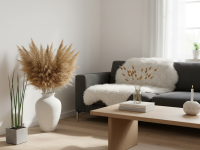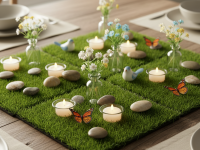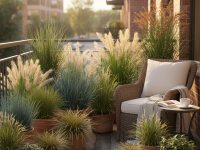There’s just something magical about a live edge dining table, isn’t there? It’s not just a piece of furniture; it’s a statement, a natural work of art that brings the organic beauty of the outdoors right into your home. If you’re anything like me, you’ve probably scrolled through countless images, admiring the unique grain patterns, the raw, untouched edges, and the sheer presence these tables command. But once you decide to bring one into your own space, the big question hits: what’s the best wood for a live edge dining table in the USA?
Trust me, I’ve been there. The journey from admiring a picture to having that perfect slab gracing your dining room can feel overwhelming. There’s so much to consider beyond just the initial “wow” factor. As someone who’s delved deep into the world of live edge, from sourcing slabs to understanding their quirks, I’ve learned a thing or two about what truly makes a wood “best.” It’s not just about aesthetics; it’s about durability, stability, and finding a material that will stand the test of time and countless family meals.
So, let’s pull up a chair, grab a coffee, and talk through the fantastic options available right here in the USA. We’ll explore the characteristics that make certain woods shine, share some personal insights, and help you navigate this exciting decision so you can craft a table that’s not just beautiful, but truly lasts.
The Heart of the Matter: What Makes a Great Live Edge Wood?
Before we dive into specific species, let’s talk about the qualities we’re looking for. A live edge dining table isn’t just any table. It’s often a substantial investment, a focal point, and it needs to endure daily life – hot plates, spilled drinks, accidental bumps, and the general hustle and bustle of a busy household. So, “best” isn’t just about what looks good; it’s a blend of several crucial factors:
- Durability & Hardness: Your table will take a beating. You want a wood that can handle impacts without denting easily. The Janka hardness scale is your friend here – higher numbers mean harder wood.
- Stability: Wood is a living material; it expands and contracts with changes in humidity. For a large slab, stability is paramount to prevent warping, cupping, or cracking over time. Properly dried wood is key, but some species are inherently more stable than others.
- Aesthetics: This is probably what drew you in! We’re talking about color, grain pattern, unique figures (like burling or crotch wood), and how the live edge itself presents.
- Workability: While you might not be doing the woodworking yourself, the ease with which a wood can be cut, sanded, and finished impacts the final product and often the cost.
- Availability & Cost: Some woods are more abundant and locally sourced in the USA, making them more accessible and potentially more affordable. Exotic woods, or very large, rare slabs, will naturally come with a higher price tag.
Top Contenders: Best Wood Species for Your Live Edge Table (USA Focus)
When I’m talking to clients or friends about their live edge dreams, these are the woods that consistently come up as top performers, each with its own unique charm and benefits.
American Black Walnut: The King of Live Edge
Ah, Walnut. If there’s one wood that seems synonymous with “luxury” and “live edge,” it’s American Black Walnut. And for good reason! Its rich, dark brown heartwood, often accented by lighter sapwood, creates a stuing contrast that’s simply breathtaking. The grain patterns are usually straight and open, but you can also find beautiful figuring like swirls and burls that add incredible character.
- Why I love it: The color deepens over time, it’s incredibly stable once properly dried, and it takes finishes beautifully, giving you that glass-smooth, opulent feel. It’s hard enough for a dining surface, too.
- Things to consider: It’s usually one of the more expensive options. Also, finding very wide, single slabs can be a challenge, as walnut trees don’t always grow as massive as some other species. But if your budget allows, a walnut live edge table is truly an heirloom piece.
Oak (White & Red): The Sturdy Classic
Oak has been a staple in furniture making for centuries, and for live edge tables, it continues to prove its worth. In the USA, we primarily deal with White Oak and Red Oak, both offering distinct characteristics.
- White Oak: This is my go-to recommendation for durability and a classic aesthetic. It’s incredibly strong, has a beautiful tight grain that can display stuing ray fleck patterns (especially quarter-sawn), and it’s naturally resistant to moisture. Its color ranges from light brown to tan, which can be stained to a wide variety of hues.
- Red Oak: While slightly softer and more porous than White Oak, Red Oak is still a formidable choice. It has a more open, pronounced grain and a reddish hue. It’s generally more abundant and can be a more budget-friendly option.
- Why I love it: Oak is a fantastic workhorse option. It’s plentiful, relatively affordable compared to walnut, and incredibly durable. If you’re looking for a table that will withstand generations of use, oak is a fantastic choice.
Maple (Hard & Soft): Bright & Beautiful
For a brighter, more contemporary look, maple is an excellent contender. We differentiate between Hard Maple (Sugar Maple) and Soft Maple, both popular in the USA.
- Hard Maple: This is one of the hardest woods available, making it incredibly durable and resistant to dents. Its light, creamy color and fine, subtle grain make it ideal for modern spaces or for those who want a lighter feel. You can also find incredible figuring in maple, like “birdseye,” “curly,” or “flame” patterns, which add unique visual interest.
- Soft Maple: Don’t let the name fool you; Soft Maple is still very hard and durable, just not quite as dense as Hard Maple. It’s often easier to work with, and you can find it in slightly wider slabs. Its color is similar, a pale cream or light brown.
- Why I love it: Maple offers a clean, elegant aesthetic. It’s very stable and takes stains well, although many prefer its natural, light appearance. It’s also very reasonably priced for its durability.
Cherry: Warmth That Ages Gracefully
If you’re drawn to warm, inviting tones, American Cherry is a simply gorgeous choice. When first cut, it has a pale pinkish-brown hue, but oh, how it transforms! With exposure to light and air, it slowly deepens into a rich, reddish-brown, developing a beautiful patina over time that’s truly unmatched.
- Why I love it: The grain is usually straight and smooth, giving a refined look. It’s relatively easy to work with and takes finishes wonderfully. For me, it’s a personal favorite for its evolving beauty and the warmth it brings to a room.
- Things to consider: It’s a bit softer than oak or maple, so it might be more prone to dents if you’re particularly rough on your furniture. However, with proper care, it makes a magnificent dining table.
Other Worthy Mentions (Depending on Location & Taste)
While the above are the most popular, don’t overlook these fantastic options, especially if you’re looking for something a bit different or have regional access:
- Ash: Often compared to White Oak in strength and grain, but with a lighter, creamy color. It’s a fantastic, durable, and more affordable alternative to oak.
- Sycamore: Features a truly unique, lace-like grain pattern that is absolutely stuing. It’s a lighter wood, but can make for a dramatic statement piece.
- Elm: Often found as reclaimed wood, Elm has an interlocking grain that makes it incredibly strong and stable, though sometimes challenging to work with. It offers a rustic, salvaged beauty.
- Mesquite (Southwest USA): Extremely hard and durable, with a highly distinctive grain and rich color. Slabs are often smaller due to the tree’s growth habit, perfect for smaller dining tables or unique accent pieces.
- Pecan (South/Southeast USA): A member of the hickory family, Pecan is incredibly hard and features a beautiful, often wild grain pattern. It’s a challenging wood to work with due to its density, but the results are stuing and exceptionally durable.
Beyond the Species: Crucial Factors to Consider When Buying
Choosing the wood species is a big step, but your journey isn’t over. My experience has taught me that these next few points are absolutely critical for a successful live edge table project:
Moisture Content is King (or Queen)!
This is arguably the most important factor, even more so than the species itself. A beautiful slab of the “best” wood will quickly become a nightmare if it’s not properly dried. Wood needs to be dried to a specific moisture content (typically 6-8% for indoor furniture in most parts of the USA) to prevent it from warping, cracking, or developing unsightly checks after it’s in your home. Always, always ask about the moisture content and how the wood was dried (kiln-dried is generally preferred for consistency and pest eradication).
Slab Dimensions and Character
Think about the size of your space and how many people you need to seat. Do you need a single, super-wide slab, or would a book-matched pair work? Also, embrace the natural character! Knots, small voids, bark inclusions, and even bug trails tell a story. Decide how much “character” you want – some people love a very rustic look, while others prefer a cleaner slab with minimal imperfections.
The Importance of a Reputable Supplier
This caot be stressed enough. Whether you’re buying a raw slab or a finished table, go to a reputable sawmill, specialty wood supplier, or artisan furniture maker. They will have the knowledge, the proper drying facilities, and a selection of quality slabs. Ask questions! A good supplier will be happy to talk about their drying process, the origin of the wood, and help you select the perfect piece.
My Personal Tips for Success
- Don’t Rush It: Finding the perfect slab takes time. Enjoy the process of looking, learning, and imagining.
- See It in Person: Pictures simply don’t do justice to the true color, grain, and feel of a live edge slab. If possible, visit the supplier or maker.
- Consider Your Finish: The finish you choose will dramatically impact the look and durability of your table. Do you want a natural oil, a durable polyurethane, or an epoxy resin? Each wood takes different finishes differently.
- Budget for Quality: A live edge table is an investment. While there are more affordable options, don’t compromise on proper drying and expert craftsmanship. It pays off in the long run.
Conclusion: Your “Best” Awaits
So, what’s the absolute “best” wood for your live edge dining table in the USA? As you can see, there’s no single answer that fits everyone. It truly boils down to your personal aesthetic, your budget, and the practical demands of your lifestyle.
Whether you fall for the luxurious depth of Walnut, the timeless strength of White Oak, the bright elegance of Maple, or the graceful warmth of Cherry, you’re choosing a piece that will be unique to you. By understanding the qualities of different woods and focusing on crucial factors like moisture content and reputable sourcing, you’re well on your way to creating a stuing live edge dining table that will be cherished for generations to come. Happy hunting, and may your dining table dreams become a beautiful reality!
1. A wide shot of a stuing live edge dining table made from dark walnut wood, showing its unique natural edge and prominent grain. The table is set in a modern, warm dining room with natural light, a family is gathered around it, laughing and enjoying a meal. The table surface is smoothly finished, reflecting the ambient light.
2. A close-up, artistic shot featuring three different types of raw live edge wood slabs leaning against a wall in a well-lit workshop. One slab is dark (e.g., walnut), one is medium-toned (e.g., cherry or oak), and one is light (e.g., maple or ash), clearly showcasing their distinct colors, grain patterns, and natural, bark-on or debarked edges. Tools are subtly blurred in the background.
3. A skilled woodworker, wearing safety glasses, meticulously inspecting a large, kiln-dried live edge wood slab with a digital moisture meter. The workshop environment is clean and organized, with various woodworking tools visible in the background, emphasizing expertise and quality control.



